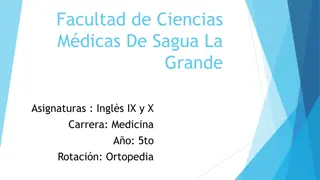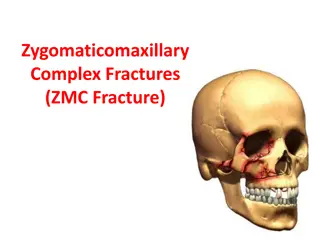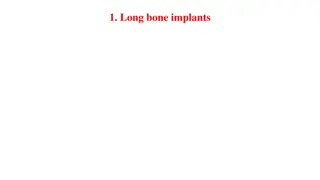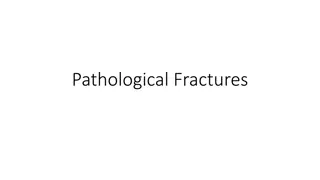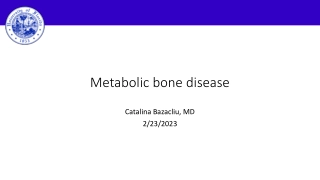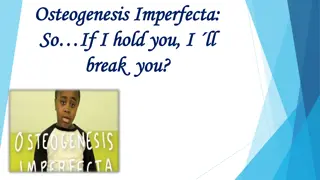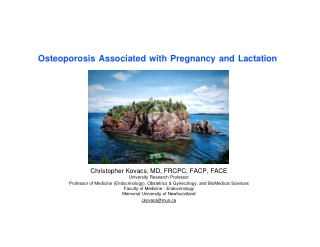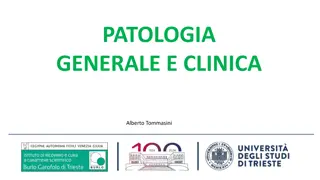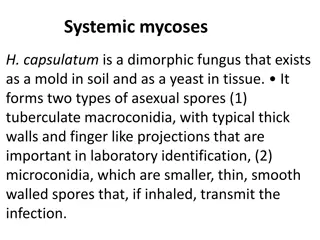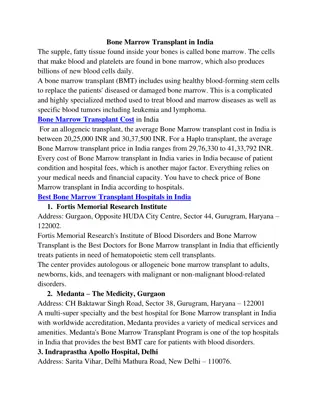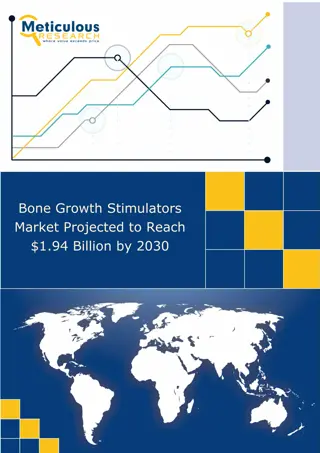Bone Fractures
Bone fractures can occur due to external forces, high-energy trauma, bone fatigue, or underlying skeletal diseases. Symptoms include pain, tenderness, swelling, and difficulty moving. Different types of fractures include nondisplaced, displaced, compound, pathological, longitudinal, and spiral fractures. Imaging techniques like X-ray, MRI, and CT scans help in diagnosis. The skeletal system plays a vital role in protecting organs, supporting muscles, and storing minerals like calcium and phosphate.
Download Presentation
Please find below an Image/Link to download the presentation.
The content on the website is provided AS IS for your information and personal use only. It may not be sold, licensed, or shared on other websites without obtaining consent from the author. Download presentation by click this link. If you encounter any issues during the download, it is possible that the publisher has removed the file from their server.
Presentation Transcript
Bone fractures Patrycja Gab o, III rok, st. Fizjoterapia, studia jednolite magisterskie
https://www.theskeletalsystem.net/types-of-bones/long-bones Anatomical structure of bones
Definition and causes of fractures A fracture is a break in the continuity of a bone caused by an external force. https://www.cmmedicum.com/leczenie- The most common causes of fractures: high-energy trauma (traffic accident, fall from height, impacts, gunshot); "bone fatigue" (often affects athletes who are subjected to heavy loads); osteoporosis or other skeletal disease operacyjne/chirurgia-reki
The basic functions of skeletal system protection of deeper organs (brain is protected by the skull, the chest protects the heart and lungs, the pelvis protects the reproductive organs) passive locomotor system support for muscles store of calcium and phosphate ions in the body indirectly hematopoietic (bone marrow is located in bones) https://www.livescience.com/22537-skeletal-system.html
Fracture symptoms sharp, growing pain that lasts for a long time local tenderness, tingling, disturbance or loss of feeling in a limb, swelling, bruising, loss of pulse near the injured area, difficulty or inability to move a limb, abnormal bone movements
https://t4.ftcdn.net/jpg/05/75/79/71 X-ray Magnetic resonance imaging (MRI) Computed tomography scan Diagnosis
Types of fractures A NONDISPLACED FRACTURE the bone axis is preserved https://my.clevelandclinic.org/health/diseases/22185- A DISPLACED FRACTURE the bone axis is not preserved A COMPOUND FRACTURE the continuity of the skin has been damadged by the bone oblique-fracture
A PATHOLOGICAL FRACTURE A fracture caused by an underlying disease which weakened the bones. A LONGITUDINAL FRACTURE A fracture going along the longitudinal axis. A SPIRAL FRACTURE A fracture going round and down the length of the bone. https://www.quora.com/Whats-the-worst-type-of- A GREENSTICK FRACTURE A partial crack, the fracture does not estend through the width of the shaft. AN OBLIQUE FRACTURE The bone is broken at an angle. A COMMINUTED FRACTURE The bone is broken into many pieces. fracture A TRANSVERSE FRACTURE The bone is broken straight across
AN INTRA-ARTICULAR FRACTURE A fracture involving the bones of a joint. 2.https://www.facebook.com/gabinetkasprzak/posts/272 1.https://www.istockphoto.com/pl/zdj%C4%99cie/z%C5 %82amany-nadgarstek-wewn%C4%85trzstawowe A COMPRESSION FRACTURE A fracture caused by hyperflexion of the spine, usually appearing in the lumbar section. 5353871033492/
Phases of bone union formation I . Hematoma formation II . Soft callus formation III . Bony callus formation IV . Bone remodeling
Treatment Immobilization of the injured limb with a plaster or splint Surgery to restore the correct bone axis (displaced fractures) Surgery to fuse bone fragments and stabilize them Traction
Rehabilitation After removing the immobilization and obtaining bone union, the following is used: transverse massage and functional massage exercises to increase joint mobility manual therapy strengthening exercises kinesio taping https://fizjo-clinica.pl/ile-trwa-rehabilitacja-po-zlamaniu- kosci-piety/
Physical therapy magnetic field, laser therapy, cryotherapy, whirlpool massage, Sollux lamp. https://vitamax.pl/metody-terapii/fizykoterapia/pole- magnetyczne/
Periosteum - okostna Dictionary Endosteum- r dkostna Medullary cavity jama szpikowa Oblique fracture z amanie sko ne Greenstick fracture - z amanie ,,zielonej ga zki Longitudinal fracture- pod u ne z amanie Compound fracture- z amanie otwarte Comminuted fracture- z amanie wielood amowe Protrusion- zgrubienie Cast immobilization- unieruchomienie gipsowe Bone marrow- szpik kostny
BIBLIOGRAPHY A. Bigham-Sadegh & A. Oryan Basic concepts regarding fracture healing and the currentoptions and future directions in managing bone fractures ; International Wound Journal ISSN 1742-4801, may 2015 Baig M (August 28, 2017) A Review of Epidemiological Distribution of Different Types of Fractures in Paediatric Age. Cureus 9(8): e1624. doi:10.7759/cureus.1624 Rodney C. Diaz , Brian Cervenka , Hilary A. Brodie, Treatment of Temporal Bone Fractures , Neurol Surg B Skull Base 2016; 77(05): 419-429, DOI: 10.1055/s-0036- 1584197 B. Wildemann, A. Ignatius, F. Leung, L. A. Taitsman, R. M. Smith, R. Pes ntez, M. J. Stoddart, R. G. Richards & J. B. Jupiter; Non-union bone fractures , Nature Reviews Disease Primers https://www.nature.com/articles/s41572-021-00289-8 https://my.clevelandclinic.org/health/diseases/15241-bone-fractures


